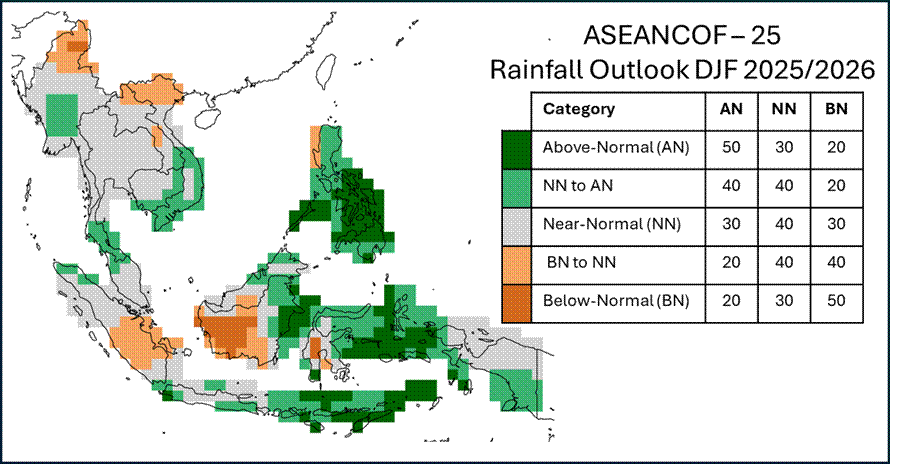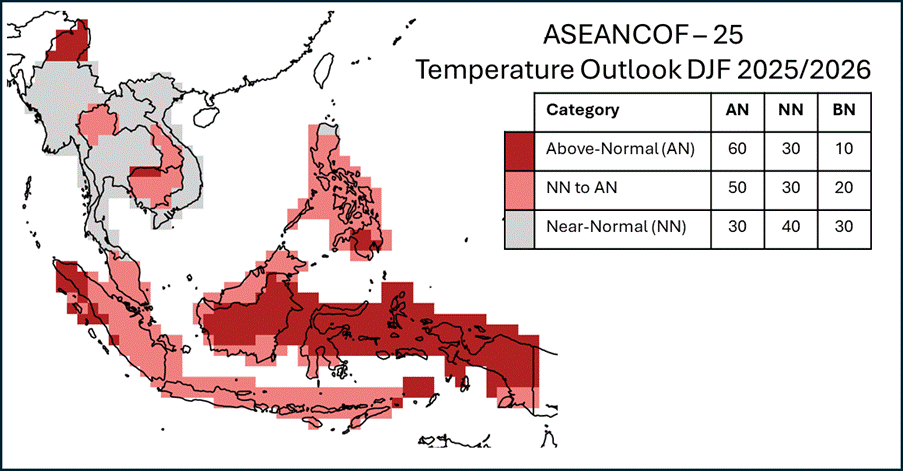Twenty Fifth Session of the ASEAN Climate Outlook Forum (ASEANCOF-25)

27 – 30 October 2025, Online
Consensus Bulletin for December-January-February (DJF) 2025/2026 Season
The ASEAN Climate Outlook Forum (ASEANCOF) is an avenue to collaboratively develop consensus-based seasonal climate outlooks and related information on a regional scale. The forum’s outlook and its activities contribute significantly to one of the key roles of the ASEAN Specialised Meteorological Centre (ASMC), which is to conduct climate and seasonal prediction for the Association of Southeast Asian Nations (ASEAN) region through pooling the expertise of ASEAN National Meteorological and Hydrological Services (NMHSs). In 2021, the ASEANCOF Working Group was established with the goal to guide and support the long-term development of ASEANCOF, in particular regarding the implementation of objective outlooks.
The Twenty-fifth session of ASEANCOF (ASEANCOF-25) was organised by the Ministry of Water Resources and Meteorology, Cambodia (MOWRAM), RIMES, ASMC, the ASEANCOF Working Group, UN ESCAP, and WMO. Participants from the NMHSs of ASEAN Member States created a consensus forecast for the boreal winter monsoon 2025/2026 in the ASEAN region. The consensus for the December-January-February (DJF) 2025/2026 outlook was achieved through an online session, which included presentations from different NMHSs, questionnaires, and discussions regarding the current climate conditions and predictions for Southeast Asia. The theme of ASEANCOF-25 was on advancing the tailoring of climate services to better meet the diverse needs of users across the ASEAN region. On the last day of ASEANCOF-25, a sharing session was held which included a panel discussion on the various uses of climate services.

Conditions and Outlook
Recent (September – October 2025) sea surface temperatures (SSTs) were below-average across the central and eastern equatorial Pacific Ocean and, along with atmospheric indicators such as stronger trade winds and increased cloudiness in the western Pacific, indicate La Niña or La Niña-like conditions. In the Indian Ocean, a negative Indian Ocean Dipole is present.
International climate outlooks predict weak or moderate La Niña conditions for December 2025 to February 2026. After DJF 2025/2026, most models indicate a transition from La Niña to ENSO-neutral conditions, although there remains a possibility that La Niña may persist beyond early 2026. The Indian Ocean Dipole (IOD) is likely to return to neutral during December 2025.
The onset of the 2025/2026 Northeast monsoon season has been or is expected to be near- or later than average for much of the northern ASEAN region. The onset for much of the southern ASEAN region is predicted to be near-average. The strength of the Northeast Monsoon is predicted to be near-average over most of Southeast Asia.
During DJF 2025/2026, tropical cyclone frequency is predicted to be above average around the Philippine Sea, and near-average for the Bay of Bengal, and South China Sea.
RAINFALL
For the upcoming boreal (Northern Hemisphere) winter season (DJF 2025/2026):
Over the Maritime Continent, near- to above-normal or above-normal rainfall is predicted for much of the eastern half of the region, including most of the Philippines, Brunei Darussalam, Sabah, and Timor-Leste. One exception is over the northwestern Philippines where below- to near-normal rainfall is predicted. For the western half, most of the region is predicted to experience either below- to near-normal or near-normal rainfall, including near-normal rainfall over Singapore, Peninsular Malaysia, and parts of East Malaysia.
Across Mainland Southeast Asia, near- to above-normal rainfall is predicted over parts of southern Mainland Southeast Asia, including southern Thailand, southern and eastern Cambodia, southern Viet Nam, as well as central Myanmar. Near- to below-normal rainfall is predicted over northern parts, including northern Myanmar, Lao PDR, and Viet Nam. Elsewhere, near-normal rainfall is predicted.
TEMPERATURE
For the upcoming boreal (Northern Hemisphere) winter season (DJF 2025/2026):
Over the Maritime Continent, near-to above-normal or above-normal temperature is predicted, apart from over the northern Philippines where near-normal temperature is predicted.
Over Mainland Southeast Asia, most of the region is predicted to experience near-normal temperature, apart from northern Myanmar, northern Thailand, central and southern Lao PDR, and most of Cambodia where near-to above-normal or above-normal temperature is predicted.
1For this outlook, near-to above-normal temperature corresponds to 50% probability of above-normal temperature, 40% near-normal, and 10% below-normal. Further information is in the consensus maps.
Refer to Annex A for reference on what is meant by “above, near, or below normal” in the outlook. For more information on the boreal (Northern Hemisphere) summer monsoon outlook and further updates on the national scale, the relevant NMHSs should be consulted (see Annex B).
CONSENSUS MAPS FOR DJF 2025/2026
The following maps provide the probabilistic outlooks for DJF 2025/2026 season in terms of tercile categories of “Above Normal” (AN: upper tercile), “Near Normal (NN: middle tercile) and “Below Normal” (BN: lower tercile).
PROBABILISTIC RAINFALL OUTLOOK
PROBABILISTIC TEMPERATURE OUTLOOK
Meeting Documents
Acknowledgements
ASEANCOF would like to convey its appreciation to the NMHSs of the ASEAN Member States for sharing their national level forecasts, the Global Producing Centres, the Southeast Asia Regional Climate Centre – Network, RIMES, UN ESCAP, FAO, USQ, GHHIN Southeast Asia Hub and other partners of ASEANCOF for sharing their products and expertise, and the World Meteorological Organization Regional Office in Asia and the Southwest Pacific (WMO-RAP) for their continued support of ASEANCOF. The Forum would also like to thank MOWRAM Cambodia for hosting the forum, with support from RIMES, CREWS and WISER Asia Pacific for the funding support provided for the meeting.



